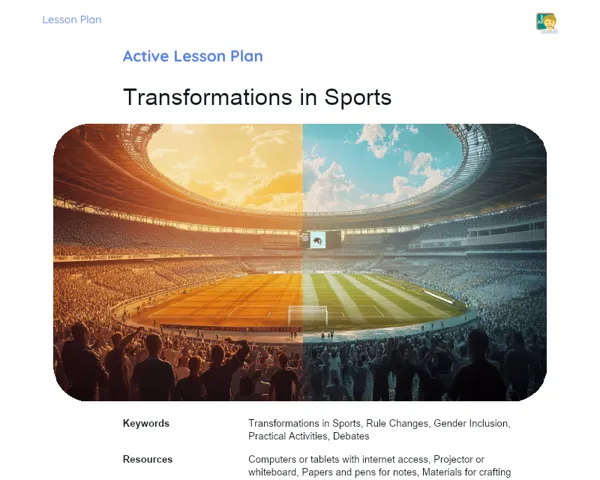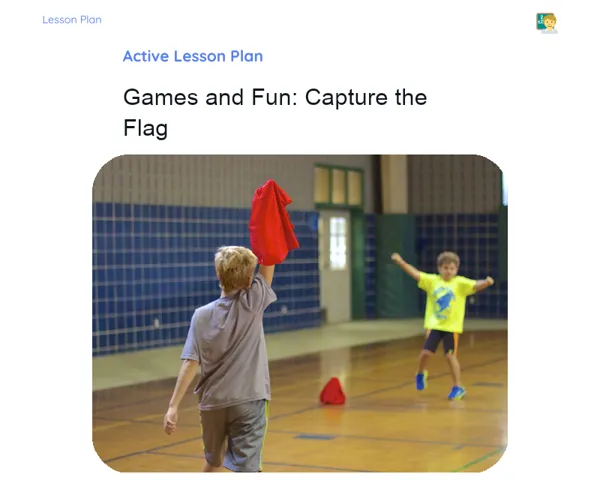Lesson Plan | Active Methodology | Body Self-Awareness
| Keywords | Body Awareness, Physical Education, Hands-on Activities, Safety, Limits and Capabilities, Body Signals, Reflection, Interactivity, Adaptive Challenges, Body Expression, Dance, Educational Games |
| Necessary Materials | Sufficient space for practical activities, Equipment for the circuit (balance beams, flexibility tasks, light weights), Music for the dance sessions, Height-adjustable bar for the limbo game, Materials for notes (notebooks, pens), Timer or clock to manage activity durations |
Premises: This Active Lesson Plan assumes: a 100-minute class duration, prior student study both with the Book and the beginning of Project development, and that only one activity (among the three suggested) will be chosen to be carried out during the class, as each activity is designed to take up a large part of the available time.
Objective
Duration: (5 - 10 minutes)
Setting clear objectives is crucial for guiding both practical and theoretical activities in class. When objectives are well defined, students can concentrate better and engage meaningfully in tasks, leading to a deeper understanding of body awareness. This step also aligns expectations and reinforces the importance of knowing and respecting their own physical boundaries.
Objective Utama:
1. Help students recognize and respect their body's limits, knowing which movements are safe and which could lead to injury.
2. Promote body awareness to understand how their bodies respond to different stimuli and physical activities.
Objective Tambahan:
- Foster interactions among students to share their experiences, enhancing the collective understanding of body awareness.
Introduction
Duration: (15 - 20 minutes)
The introduction stage aims to trigger students' prior knowledge and engage them with the lesson's central theme practically. The problem situations inspire students to think critically about their body responses, setting a solid foundation for applying body awareness. Contextualization reinforces the theme's relevance in their everyday lives, boosting their interest and motivation to learn.
Problem-Based Situation
1. Imagine you're at a park and want to climb a tall structure. What signals might your body give you to say this isn't safe?
2. Think about a dance class where the instructor asks you to try a new step. Do you feel comfortable with this, or do you sense discomfort? What might that indicate about the movement?
Contextualization
Awareness of our bodies is key for safety and overall well-being in daily life. Understanding how our bodies work and their limits helps prevent injuries and promotes good health. Additionally, being attuned to our body allows us to improve in physical activities and express ourselves better — be it in dance, sports, or even routine tasks like lifting heavy objects or maneuvering in confined spaces. Many athletes and dancers stress that body awareness is vital for their achievements.
Development
Duration: (70 - 75 minutes)
The development phase lets students apply their knowledge of body awareness through practical and engaging activities. They explore their movement boundaries while identifying warning signals, learning to make conscious, safe choices for their well-being. This stage is crucial to cementing theoretical concepts into actionable understanding.
Activity Suggestions
It is recommended that only one of the suggested activities be carried out
Activity 1 - Self-Awareness Circuit
> Duration: (60 - 70 minutes)
- Objective: Build body awareness skills through varied movement challenges.
- Description: In this activity, students will navigate a series of stations, each crafted to test and enhance their body awareness. Each station presents distinct challenges — balance, flexibility, or strength — that students will tackle using their prior knowledge about their bodies' limits.
- Instructions:
-
Split the class into groups of up to 5 students.
-
Briefly explain each station and demonstrate the challenges to ensure clarity.
-
Before starting, groups should discuss how their bodies can handle the challenges and what warning signs to look for.
-
Monitor each group throughout the circuit, providing assistance and correcting postures as needed.
-
Convene as a class afterward to discuss experiences from each station and insights gained about their bodies.
Activity 2 - The Knowledge Limbo
> Duration: (60 - 70 minutes)
- Objective: Teach students to assess risks and apply body awareness in a fun, engaging way.
- Description: Students will engage in a limbo game infused with a learning aspect. As they try to go under a progressively lowered bar, they must evaluate whether the movement is safe and comfortable for them. The bar height will change periodically, forcing students to decide on their attempt.
- Instructions:
-
Set up a play area with an adjustable horizontal bar.
-
Students line up, taking turns to determine if they can go under the bar.
-
Prior to each try, each student must articulate why they believe they can or cannot pass safely.
-
Those who succeed must express how their bodies adapted and why they believed they could proceed.
-
Wrap up with a discussion about the strategies and decisions made.
Activity 3 - Dance of the Senses
> Duration: (60 - 70 minutes)
- Objective: Encourage expression of body awareness through dance and foster appreciation for various movements.
- Description: Students will experiment with various dance styles (like hip-hop, ballet, contemporary) through small performances. Each group will select a style and create a dance that allows exploration and expression of their body awareness.
- Instructions:
-
Divide students into groups, assigning a dance style to each.
-
Groups should discuss which movements feel comfortable and which may pose a challenge.
-
Each group will prepare a short routine that incorporates these movements, focusing on expressing their understanding of their body's limits.
-
Perform routines, followed by reflections from each student on their performance experience and insights about their bodies.
-
Lead a class discussion about how different dance forms challenge and complement body awareness.
Feedback
Duration: (15 - 20 minutes)
This stage aims to solidify both practical and theoretical understandings of body awareness, allowing students to articulate and reflect on their experiences. The group discussion reinforces comprehension of the concepts and encourages shared learning among students while providing an opportunity to evaluate their grasp of the topic and identify areas needing further exploration.
Group Discussion
To kick off the discussion, the teacher can prompt each group to share vital takeaways from their activities. Use this structure: (1) Ask groups to describe the challenges they faced and lessons learned. (2) Invite students to share any unexpected insights or shifts in perspective. (3) Discuss how they can apply this knowledge in real-world situations or other physical endeavors.
Key Questions
1. What signals did your body convey during the activities about comfort or overexertion?
2. How did you adjust your movements based on what you learned about your body today?
3. Did you encounter any risky situations where you chose not to participate? What influenced that decision?
Conclusion
Duration: (10 - 15 minutes)
The conclusion stage seeks to ensure that students effectively internalize the knowledge gained during the lesson and understand how to apply body awareness in various contexts. Recapping reinforces the learning of essential concepts and discussing theory-practice relevance underlines the importance of body awareness for students' health and overall well-being.
Summary
In the closure of the lesson, the teacher should recap key points on body awareness, emphasizing how students identified and navigated the boundaries of their bodies through hands-on activities. Revisit concepts of safety, adaptation, and respecting body signals during various movements.
Theory Connection
Throughout the lesson, the teacher connected theory with practice by facilitating challenging and interactive activities. This approach enabled students to witness the practical relevance of their learning in real-life scenarios, highlighting the use of this knowledge for ensuring safety and well-being.
Closing
To conclude, it's essential to stress the significance of body awareness in daily life. Understanding our own limits and capabilities not only helps in sports but also in everyday tasks, like lifting heavy objects or maneuvering safely. This knowledge, combined with the practice of heeding body signals, is vital for a healthy, active lifestyle.


